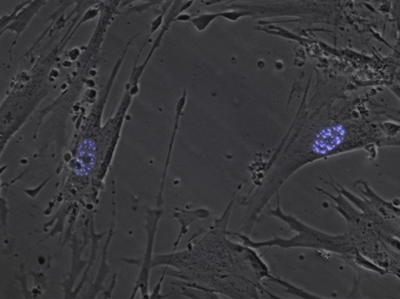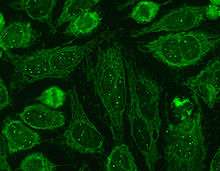Nuclear bodies
Nuclear bodies (also known as nuclear domains, or nuclear dots, are membraneless structures found in the cell nuclei of eukaryotic cells.[1] Nuclear bodies include Cajal bodies, the nucleolus, and promyelocytic leukemia protein (PML) nuclear bodies (also called PML oncogenic dots).[2] Nuclear bodies also include ND10s. ND stands for nuclear domain, and 10 refers to the number of dots seen.[3]


Nuclear bodies were first seen as prominent interchromatin structures in the nuclei of malignant or hyperstimulated animal cells[4][5] identified using anti-sp100 autoantibodies from primary biliary cirrhosis and subsequently the promyelocytic leukemia (PML) factor, but appear also to be elevated in many autoimmune and cancerous diseases.[6] Nuclear dots are metabolically stable and resistant to nuclease digestion and salt extraction.[7]
A nuclear body subtype is a clastosome suggested to be a site of protein degradation.[8]
Structure
Simple nuclear bodies (types I and II) and the shells of complex nuclear bodies (types III, IVa and V) consist of a non-chromatinic fibrillar material which is most likely proteinaceous.[9] That nuclear bodies co-isolated with the nuclear matrix, and were linked to the fibrogranular nuclear matrix component by projections from the surface of the nuclear bodies.[9] The primary components of the nuclear dots are the proteins sp100 nuclear antigen, LYSP100(a homolog of sp100),[10] ISG20,[11] PML antigen, NDP55 and 53kDa protein associated with the nuclear matrix.[12] Other proteins, such as PIC1/SUMO-1, which are associated with nuclear pore complex also associate with nuclear dots.[13] The proteins can reorganize in the nucleus, by increasing number of dispersion in response to different stress (stimulation or heat shock, respectively).[14]
Function
One of the nuclear body proteins appears to be involved in transcriptional active regions.[15] Expression of PML antigen and sp100 is responsive to interferons. Sp100 seems to have transcriptional transactivating properties. PML protein was reported to suppress growth and transformation,[5] and specifically inhibits the infection of vesicular stomatitis virus (VSV) (a rhabdovirus) and influenza A virus,[16] but not other types of viruses. The SUMO-1 ubiquitin like protein is responsible for modifying PML protein such that it is targeted to dots.[17] whereas overexpression of PML results in programmed cell death.[18]
One hypothesized function of the dots is as a 'nuclear dump' or 'storage depot'. [19] The nuclear bodies may not all perform the same function. Sp140 associates with certain bodies and appears to be involved in transcriptional activation.[20]
ND10 nuclear bodies have been shown to play a major role in chromatin regulation.[21]
Pathology
These, or similar, bodies have been found increased in the presence of lymphoid cancers[22][23] and SLE (lupus).[24] They are also observed at higher frequencies in subacute sclerosing panencephalitis; in this instance, antibodies to measles show expression in and localization to the nuclear bodies.[25]
- In promyelocytic leukemia (PML), the oncogenic PML-retinoic acid receptor alpha (RARalpha) chimera disrupts the normal concentration of PML in nuclear bodies. Administraton of arsenic trioxide (As2O3) plus all-trans retinoic acid (Tretinoin) causes remission of this leukemia by triggering the bodies' reorganization. As2O3 destroys the chimera, allowing new SUMO-1 ubiquitinated PML to relocalize to nuclear bodies.[17] Retinoic acid induces a caspase-3 mediated degradation of the same chimera.[26]
- In HHV, ICP0 disrupts nuclear dots in the early stage of infection.[27]
References
- Weber SC (June 2017). "Sequence-encoded material properties dictate the structure and function of nuclear bodies". Current Opinion in Cell Biology. 46: 62–71. doi:10.1016/j.ceb.2017.03.003. PMID 28343140.
- Zimber A, Nguyen QD, Gespach C (October 2004). "Nuclear bodies and compartments: functional roles and cellular signalling in health and disease". Cellular Signalling. 16 (10): 1085–104. doi:10.1016/j.cellsig.2004.03.020. PMID 15240004.
- Rivera-Molina YA, Martínez FP, Tang Q (August 2013). "Nuclear domain 10 of the viral aspect". World Journal of Virology. 2 (3): 110–22. doi:10.5501/wjv.v2.i3.110. PMC 3832855. PMID 24255882.
- Brasch K, Ochs RL (October 1992). "Nuclear bodies (NBs): a newly "rediscovered" organelle". Experimental Cell Research. 202 (2): 211–23. doi:10.1016/0014-4827(92)90068-J. PMID 1397076.
- Sternsdorf T, Grötzinger T, Jensen K, Will H (December 1997). "Nuclear dots: actors on many stages". Immunobiology. 198 (1–3): 307–31. doi:10.1016/s0171-2985(97)80051-4. PMID 9442402.
- Pawlotsky JM, Andre C, Metreau JM, Beaugrand M, Zafrani ES, Dhumeaux D (July 1992). "Multiple nuclear dots antinuclear antibodies are not specific for primary biliary cirrhosis". Hepatology. 16 (1): 127–31. doi:10.1002/hep.1840160121. PMID 1319948.
- Ascoli CA, Maul GG (March 1991). "Identification of a novel nuclear domain". The Journal of Cell Biology. 112 (5): 785–95. doi:10.1083/jcb.112.5.785. PMC 2288866. PMID 1999457.
- Lafarga M, Berciano MT, Pena E, Mayo I, Castaño JG, Bohmann D, et al. (August 2002). "Clastosome: a subtype of nuclear body enriched in 19S and 20S proteasomes, ubiquitin, and protein substrates of proteasome". Molecular Biology of the Cell. 13 (8): 2771–82. doi:10.1091/mbc.e02-03-0122. PMC 117941. PMID 12181345.
- Chaly N, Setterfield G, Kaplan JG, Brown DL (1983). "Nuclear bodies in mouse splenic lymphocytes: II - Cytochemistry and autoradiography during stimulation by concanavalin A". Biology of the Cell. 49 (1): 35–43. doi:10.1111/j.1768-322x.1984.tb00220.x. PMID 6199062.
- Dent AL, Yewdell J, Puvion-Dutilleul F, Koken MH, de The H, Staudt LM (August 1996). "LYSP100-associated nuclear domains (LANDs): description of a new class of subnuclear structures and their relationship to PML nuclear bodies". Blood. 88 (4): 1423–6. doi:10.1182/blood.V88.4.1423.bloodjournal8841423. PMID 8695863.
- Gongora C, David G, Pintard L, Tissot C, Hua TD, Dejean A, Mechti N (August 1997). "Molecular cloning of a new interferon-induced PML nuclear body-associated protein". The Journal of Biological Chemistry. 272 (31): 19457–63. doi:10.1074/jbc.272.31.19457. PMID 9235947.
- Zuber M, Heyden TS, Lajous-Petter AM (1995). "A human autoantibody recognizing nuclear matrix-associated nuclear protein localized in dot structures". Biology of the Cell. 85 (1): 77–86. doi:10.1016/0248-4900(96)89129-5. PMID 8882521.
- Sternsdorf T, Jensen K, Will H (December 1997). "Evidence for covalent modification of the nuclear dot-associated proteins PML and Sp100 by PIC1/SUMO-1". The Journal of Cell Biology. 139 (7): 1621–34. doi:10.1083/jcb.139.7.1621. PMC 2132645. PMID 9412458.
- Maul GG, Yu E, Ishov AM, Epstein AL (December 1995). "Nuclear domain 10 (ND10) associated proteins are also present in nuclear bodies and redistribute to hundreds of nuclear sites after stress". Journal of Cellular Biochemistry. 59 (4): 498–513. doi:10.1002/jcb.240590410. PMID 8749719.
- Xie K, Lambie EJ, Snyder M (October 1993). "Nuclear dot antigens may specify transcriptional domains in the nucleus". Molecular and Cellular Biology. 13 (10): 6170–9. doi:10.1128/MCB.13.10.6170. PMC 364676. PMID 8413218.
- Chelbi-Alix MK, Quignon F, Pelicano L, Koken MH, de Thé H (February 1998). "Resistance to virus infection conferred by the interferon-induced promyelocytic leukemia protein". Journal of Virology. 72 (2): 1043–51. doi:10.1128/JVI.72.2.1043-1051.1998. PMC 124576. PMID 9444998.
- Müller S, Matunis MJ, Dejean A (January 1998). "Conjugation with the ubiquitin-related modifier SUMO-1 regulates the partitioning of PML within the nucleus". The EMBO Journal. 17 (1): 61–70. doi:10.1093/emboj/17.1.61. PMC 1170358. PMID 9427741.
- Quignon F, De Bels F, Koken M, Feunteun J, Ameisen JC, de Thé H (November 1998). "PML induces a novel caspase-independent death process". Nature Genetics. 20 (3): 259–65. doi:10.1038/3068. PMID 9806544.
- Maul GG (August 1998). "Nuclear domain 10, the site of DNA virus transcription and replication". BioEssays. 20 (8): 660–7. doi:10.1002/(SICI)1521-1878(199808)20:8<660::AID-BIES9>3.0.CO;2-M. PMID 9780840.
- Bloch DB, Chiche JD, Orth D, de la Monte SM, Rosenzweig A, Bloch KD (June 1999). "Structural and functional heterogeneity of nuclear bodies". Molecular and Cellular Biology. 19 (6): 4423–30. doi:10.1128/MCB.19.6.4423. PMC 104401. PMID 10330182.
- Gu H, Zheng Y (April 2016). "Role of ND10 nuclear bodies in the chromatin repression of HSV-1". Virology Journal. 13: 62. doi:10.1186/s12985-016-0516-4. PMC 4822283. PMID 27048561.
- Rivas C, Oliva H (1974). "Nuclear bodies in Hodgkin's disease". Pathologia Europaea. 9 (4): 297–301. PMID 4457783.
- Tani E, Ametani T (1975). Nuclear characteristics of malignant lymphoma in the brain. Acta Neuropathologica. Supplementum. Suppl 6. pp. 167–71. doi:10.1007/978-3-662-08456-4_28. ISBN 978-3-540-07208-9. PMID 168720.
- Jones JM, Martinez AJ, Joshi VV, McWilliams N (March 1975). "Systemic lupus erythematosus". Archives of Pathology. 99 (3): 152–7. PMID 164172.
- Brown HR, Thormar H (November 1976). "Immunoperoxidase staining of simple nuclear bodies in sclerosing panencephalitis (SSPE) by antiserum to Measles nucleocapsids". Acta Neuropathologica. 36 (3): 259–67. doi:10.1007/BF00685370. PMID 795259.
- Nervi C, Ferrara FF, Fanelli M, Rippo MR, Tomassini B, Ferrucci PF, et al. (October 1998). "Caspases mediate retinoic acid-induced degradation of the acute promyelocytic leukemia PML/RARalpha fusion protein". Blood. 92 (7): 2244–51. PMID 9746761.
- Schneider SM, Pritchard SM, Wudiri GA, Trammell CE, Nicola AV (May 2019). Dermody TS (ed.). "Early Steps in Herpes Simplex Virus Infection Blocked by a Proteasome Inhibitor". mBio. 10 (3): e00732–19, /mbio/10/3/mBio.00732–19.atom. doi:10.1128/mBio.00732-19. PMC 6520451. PMID 31088925.